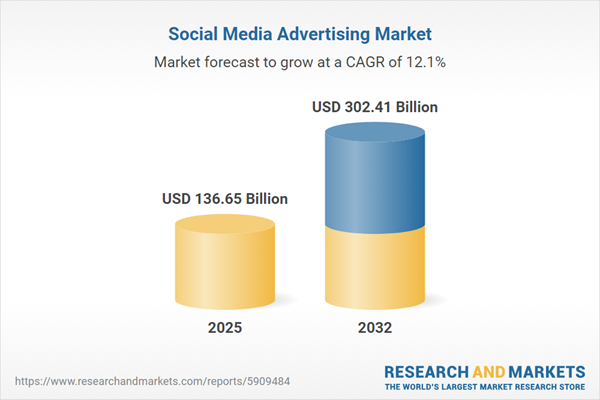Speak directly to the analyst to clarify any post sales queries you may have.
Senior leaders in the social media advertising market face a rapidly shifting environment. Success depends on agility, strong data management, and strategic navigation of regulatory and technology changes to deliver measurable business impact.
Market Snapshot: Social Media Advertising Market Size and Growth
As of 2024, the global social media advertising market is valued at USD 121.66 billion, with projections rising to USD 136.65 billion by 2025 and expected to reach USD 302.41 billion by 2032. Market growth is driven by precise targeting capabilities, advanced analytics natively integrated into platforms, and increasing synergy with digital commerce. Key dynamics shaping this landscape include the proliferation of new privacy regulations, surging mobile usage, and continued evolution in ad engagement formats. Ongoing innovation in creative ad design and data-driven campaign tactics is enhancing overall efficacy, facilitating broader brand influence across digital channels, and giving rise to new opportunities for performance optimization.
Scope & Segmentation: Strategic Focus for Senior Decision-Makers
This report provides a practical segmentation framework for executives to pinpoint revenue opportunities, minimize operational challenges, and implement focused advertising strategies. The following segments reflect critical levers for superior campaign alignment and resource efficiency:
- Platform: Assess leading channels including Facebook, Instagram, LinkedIn, Pinterest, Snapchat, TikTok, Twitter, and YouTube. Match marketing objectives and content strategy to each platform’s user demographics and engagement profiles.
- Ad Format: Select from carousel ads, display banners, sponsored posts, stories, and video content. Align creative execution with the expectations of your core audience and maximize the effectiveness of each format.
- Industry Vertical: Customize campaigns for sectors such as automotive, consumer electronics, finance, FMCG, healthcare, retail, telecommunications, and travel. Address specific industry priorities and leverage metrics relevant to each vertical.
- Device Type: Utilize cross-device strategies to address audiences on desktops, mobiles, and tablets. Optimize campaign delivery to reach users wherever they interact, adjusting creative assets for user environment.
- Demographics: Segment by age, gender, and income for refined targeting and messaging. Support greater personalization and enhance engagement across distinct market segments.
- Advertising Objective: Set clear goals such as brand awareness, app installs, user engagement, lead generation, or expanding digital presence. Unify campaigns with business outcomes in mind for higher returns.
- Payment Model: Choose from cost-per-action, cost-per-click, cost-per-mille, or cost-per-view models. These enable greater transparency and encourage accurate tracking of resource allocation and campaign ROI.
- Regional Coverage: Customize messaging for the Americas, EMEA, and Asia-Pacific. Adapt strategies to local compliance mandates and cultural preferences to realize effective global outcomes.
- Key Companies: Monitor strategic developments from Meta Platforms, Alphabet, ByteDance, Tencent, Snap, X Corp., Pinterest, Microsoft, Reddit, and Sina Corporation. Inform competitive positioning based on market leaders’ activities and trends.
Key Takeaways: Insights for Strategic Direction in Social Media Advertising
- AI-driven analytics are raising the bar for campaign targeting, supporting resilience amid shifting compliance and data privacy frameworks.
- Real-time insights into campaign and audience data equip executives to pivot marketing strategy quickly in response to evolving trends.
- Evolving creative formats with integrated commerce features streamline conversion pathways and enhance attribution models for informed decision-making.
- Cohesive brand messaging across device types fosters customer trust and extends brand visibility into both established and emerging markets.
- Privacy-focused targeting techniques allow organizations to address new regulatory requirements while reducing reliance on external data sources.
- Emphasizing first-party data collection creates synergy between marketing, technology, and strategic planning efforts, supporting long-term market adaptability.
Tariff Impact on Advertisers
Upcoming U.S. tariffs slated for 2025 are expected to generate additional complexities, especially for brands within consumer electronics. Rising costs for advertising equipment will necessitate tighter cross-functional collaboration to maintain cost-effective messaging and robust financial oversight. Adjusting creative strategies and diversifying campaign channels can help organizations stay aligned with changing consumer sentiment and comply with evolving regulatory requirements.
Methodology & Data Sources
Our methodology integrates primary research with senior marketing executive interviews, continuous observation of live social media campaigns, secondary industry research, and current compliance analysis. These combined data sources enable comprehensive tracking of technological advances and regulation within the sector.
Why This Report Matters
- Enables executive teams to refine advertising investments and manage regulatory shifts through detailed segmentation and technology insights.
- Clarifies operational frameworks, empowering distributed teams to act decisively in an evolving environment.
- Delivers actionable guidance to accelerate digital transformation and support sustainable organizational agility.
Conclusion
Adopting analytics-led, flexible, and compliance-aware approaches equips organizations to respond to market shifts and secure resilient growth as the social media advertising landscape continues to evolve.
Additional Product Information:
- Purchase of this report includes 1 year online access with quarterly updates.
- This report can be updated on request. Please contact our Customer Experience team using the Ask a Question widget on our website.
Table of Contents
3. Executive Summary
4. Market Overview
7. Cumulative Impact of Artificial Intelligence 2025
Companies Mentioned
The companies profiled in this Social Media Advertising market report include:- Meta Platforms, Inc.
- Alphabet Inc.
- ByteDance Ltd.
- Tencent Holdings Limited
- Snap Inc.
- X Corp.
- Pinterest, Inc.
- Microsoft Corporation
- Reddit, Inc.
- Sina Corporation
Table Information
| Report Attribute | Details |
|---|---|
| No. of Pages | 198 |
| Published | October 2025 |
| Forecast Period | 2025 - 2032 |
| Estimated Market Value ( USD | $ 136.65 Billion |
| Forecasted Market Value ( USD | $ 302.41 Billion |
| Compound Annual Growth Rate | 12.0% |
| Regions Covered | Global |
| No. of Companies Mentioned | 11 |









